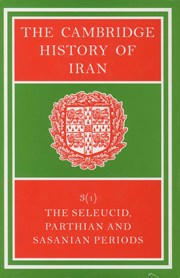Book contents
- Frontmatter
- Introduction
- PART 1 POLITICAL HISTORY
- 1 THE SELEUCID PERIOD
- 2 THE POLITICAL HISTORY OF IRAN UNDER THE ARSACIDS
- 3 IRANIANS IN ASIA MINOR
- 4 THE POLITICAL HISTORY OF IRAN UNDER THE SASANIANS
- 5 THE HISTORY OF EASTERN IRAN
- 6 THE POLITICAL HISTORY OF TRANSOXIANA
- 7 THE IRANIAN SETTLEMENTS TO THE EAST OF THE PAMIRS
- PART 2 NUMISMATICS
- PART 3 IRANIAN HISTORICAL TRADITION
- PART 4 IRAN AND HER NEIGHBOURS
- Bibliography
- Plate section
- Plate section
- Plate section
- Map 3. The western regions of the Sasanian empire">
- Map 11. The Silk Road from China to the Roman Orient
- References
7 - THE IRANIAN SETTLEMENTS TO THE EAST OF THE PAMIRS
from PART 1 - POLITICAL HISTORY
Published online by Cambridge University Press: 28 March 2008
- Frontmatter
- Introduction
- PART 1 POLITICAL HISTORY
- 1 THE SELEUCID PERIOD
- 2 THE POLITICAL HISTORY OF IRAN UNDER THE ARSACIDS
- 3 IRANIANS IN ASIA MINOR
- 4 THE POLITICAL HISTORY OF IRAN UNDER THE SASANIANS
- 5 THE HISTORY OF EASTERN IRAN
- 6 THE POLITICAL HISTORY OF TRANSOXIANA
- 7 THE IRANIAN SETTLEMENTS TO THE EAST OF THE PAMIRS
- PART 2 NUMISMATICS
- PART 3 IRANIAN HISTORICAL TRADITION
- PART 4 IRAN AND HER NEIGHBOURS
- Bibliography
- Plate section
- Plate section
- Plate section
- Map 3. The western regions of the Sasanian empire">
- Map 11. The Silk Road from China to the Roman Orient
- References
Summary
Although it was in 1922 that Rostovtzeff said, “We know but little of the history and archaeology of Central Asia and of the Iranian world”, these words remain valid today. Nomadic tribes speaking languages of Iranian origin must have been wandering about Central Asia from a very early period, probably from the first half of the second millennium B.C., but we do not know when they first began to settle in permanent villages. Isolated families may well have settled among foreigners from the earliest times.
In the case of one Iranian settlement in Central Asia that attained great fame in the first millennium A.D., we have several versions of the circumstances attending its foundation. But despite the prominence of the Iranian inhabitants of Khotan in this period, we have no information concerning their arrival. According to the Chinese and Tibetan accounts, which there is no reason to distrust, at any rate with regard to the broad outline of their accounts, the foundation of Khotan was effected by a compromise between exiled groups of Indians on the one hand and of Chinese on the other. All four of the accounts we have connect the Indian colonizing party with the son and ministers of the emperor Aśoka. This would place the foundation of Khotan firmly in the 3rd century B.C. The four accounts we have are found in two Chinese sources and in two Tibetan sources. The earliest is the account given by the Chinese Buddhist pilgrim Hsüan-tsang in his Hsi-yü-chi, dated to the 7th century A.D.
Keywords
- Type
- Chapter
- Information
- The Cambridge History of Iran , pp. 263 - 276Publisher: Cambridge University PressPrint publication year: 1983
References
- 1
- Cited by

